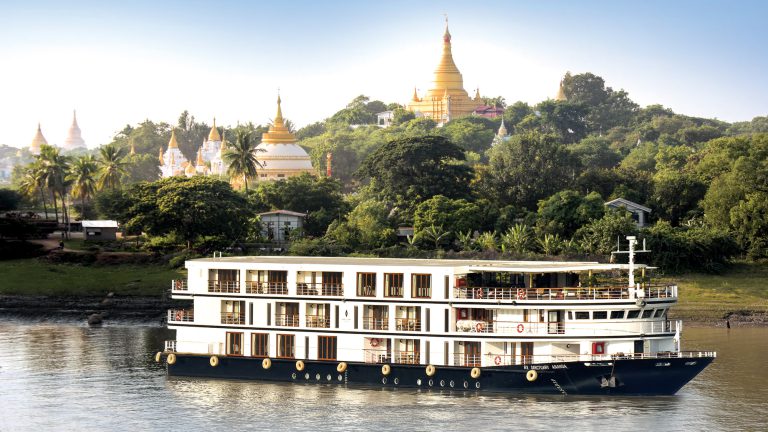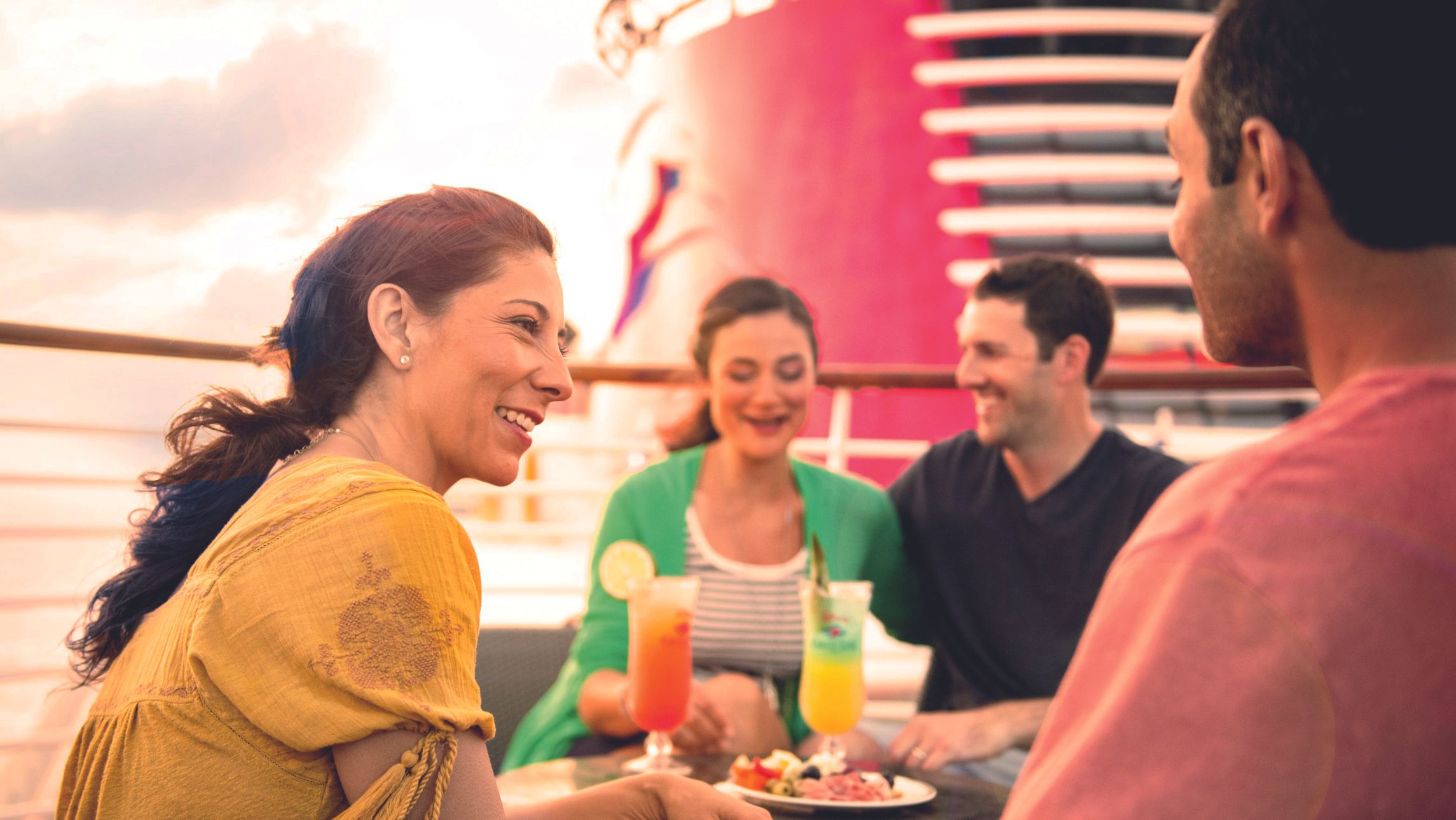Sue Bryant falls under the spell of Myanmar’s surreal beauty as she joins a luxurious new vessel on the Irrawaddy River.
I’m perched on a ledge on top of the Shwesandaw Pagoda, one of 2,000 ancient monuments scattered across the plain of Bagan on the bank of the Irrawaddy. The river glints in the distance as the sun begins its descent towards a row of hills, the warm sandstone around me assuming a rosy glow. Pagodas, some stepped, some rounded, pierce the horizon as far as the eye can see. Dozens of other travellers have clambered up here, too, cameras poised, waiting for the sunset. I hear voices from Britain, Japan and the US as well as Australia, although people fall silent as the sun finally disappears in a fiery ball.
Bagan, a seat of Burmese royalty from the ninth to the 13th centuries, is without doubt one of the highlights of a week cruising the Irrawaddy, for its sheer richness and immense scale. It is here that I join the 42-passenger Sanctuary Ananda, one of several new boats launched in the last few months.
Built in Yangon, Ananda is adorned with dark wood fittings and tasteful objets d’art, the wooden sun deck scattered with colourful cushions and sunloungers around a small pool. All the cabins have balconies and big bathrooms with walk-in showers. The accommodation is some of the most luxurious on the river, each cabin featuring polished wood, stripped floors and sumptuous silks and thick cottons. The river views from the floor-to-ceiling windows are gorgeous, although fearsome clouds of insects at sunset keep us inside, rather than on our balcony. For some reason, the beds are the tallest I’ve ever come across and we get constant fits of giggles clambering onto them until one day I discover a mounting block hidden underneath. Still, ascending a step into bed gives you a kind of regal feel.
Some things work and others don’t; the internet is extremely patchy and the TV has no sound – but who goes to Myanmar to watch TV?
The crew is local, although some of them have been recruited from flashy hotels in the Gulf for their international experience. Like all the Burmese I meet, they have ready smiles and an unassuming charm. We’re soon exchanging banter with the waiters in the dining room and the bartenders in the lounge. People gather here for pre-dinner drinks and for talks on how to tie a longyi (a Burmese sarong), and the history and politics of Myanmar. In truth, though, you’d need a full ship and some dance music to get the lounge going after dinner; on my cruise, people took longer over dinner and then faded away to bed.
The gentleness of the people, all the more surprising given what they’ve been through, is what I quickly grow to love about Myanmar. Although the country is perched on the brink of a tourism boom, it remains largely unspoilt. Outside the cities, daily life hasn’t really changed. Women still paint their faces with a yellow paste made from the bark of the thanakha tree and men still wear the longyi sarong. Life revolves around the temple and superstition governs everything. On full moon days, which are special in the Buddhist calendar, nobody seems to do much work.
There’s a surreal element to Myanmar and some of its eccentricities are clues to the often irrational whims of the former regime, with which ordinary people had to live. For a start, they drive on the right here – but in right-hand-drive cars, which makes it pretty hard to overtake. The story is that in 1970, General Ne Win decided that although Burma, as it was then called, had inherited driving on the left from the British, switching to the right would be a better idea as left was symbolically unacceptable, politically speaking.
Traffic-clogged Yangon would be freer if bicycles and motorbikes were allowed but they were banned in 2003, allegedly because a motorcyclist stopped in traffic next to a car carrying an important general and made a pistol sign with his hand.
Some cultural differences are more amusing. The national sport, for example, is called chinlone and at dinner one night we’re entertained by a young girl in spangled soccer kit demonstrating the art of keepy-uppy for hours on end. You’ll see shaven-headed, maroon-clad monks everywhere but instead of posing contemplatively for tourist photos, they’re busy snapping one another on shiny new iPads. Everywhere, there’s a love of tacky neon, with coloured disco lights often forming a halo around a shimmering golden Buddha, or framing a market stall.
Ananda, like other boats, sails different stretches of the river at different times of year, as the Irrawaddy is both capricious and threaded with dangerous sandbanks. I visit in December, the dry season, when boatmen with black-and-white striped poles have to stand at the front of every vessel, testing the depth and shouting the clearance back at the captain. We see more than one that’s run aground during the week as we cruise from Bagan to Mandalay and back.
My fellow travellers are a mixture; Europeans and North Americans escaping their winter and Australians squeezing in a pre-Christmas break. I meet rich farmers from New South Wales and retirees from the Gold Coast, as well as couples from New York, Hong Kong and London. Some are here for the culture, while others have done the Mekong and want to see a less commercial side of Southeast Asia.
After just one magnificent golden stupa on the first day, I hear the farmer puffing, “Gee, I’m templed-out.” But there’s no pressure to follow a relentless sightseeing program. One day, when we’re tied up at Bagan, I duck out of the tour and spend a lazy afternoon on deck, half-dozing in the sun, listening to roosters crowing and watching a green bird with red wings diving for insects.
Cruising the Irrawaddy is all about early nights and early mornings; we start early to make the next destination and stop at nightfall as there’s no traffic on the river after dark. North of Mandalay, I get up before dawn to visit the village of Sin Kyun, in which Sanctuary Retreats sponsors the library. Pink streaks are only just beginning to light the sky but the village is already bustling with activity; as luck would have it, we’ve turned up on the chief’s birthday and he has prepared breakfast for the whole community, including us. A great vat of oily, yellow-tinted fish-head soup simmers over a crackling wood fire. A small crowd gathers to watch; we stand out with our cameras and sunglasses and politely refusing the brew is clearly not an option. The soup is tangy and tasty, although I don’t quite manage the fish heads.
On the way back to the boat, tiny children skip behind us along the dusty path, chattering. Women sit outside their houses, returning my greeting of “mingalaba” (meaning “auspicious wishes”, the most important Burmese term you’ll learn) and weaving hats to sell in the local market.
Despite the unexpected success of the fish soup, Burmese food turns out to be disappointingly dense and fatty. On board we eat mostly Thai, with Burmese influences, prepared by Chef Sumet, a big TV celebrity back in Thailand with many years under his belt at the Mandarin Oriental, Bangkok. His food is sublime. We binge on everything, some of it new, some familiar to Australians: salads of morning glory and crushed peanuts; shredded green papaya with yellow limes; chilli noodles for breakfast. After what I figure to be six curries or noodle dishes a day from the lunch and dinner menus, it’s time to hit the small gym on board.
Luckily, there’s more exercise in store on a day trip to Mount Popa, 60 kilometres from Bagan. We drive through endless coconut palm groves towards a vast, extinct volcano 1,500 metres above sea level. As the lowlands swell into gentle, forested foothills, we’re confronted with the sheer-sided volcanic plug of holy Taung Kalat, a skyscraper of solid rock rearing improbably out of the trees with a cluster of gold stupas clinging precariously to the top, 800 steps up. The rock is said to be inhabited by nats, or spirits, who mustn’t be displeased, so nobody is allowed to climb it if they’re wearing red, black or green. Climbing up means running the gauntlet of dozens of wily macaques, adept at stealing sunglasses or spraying tourists with cans of drink, but the views, all the way back to Bagan, are worth it.
In Mandalay, I join an excursion to the U Bein Bridge, the world’s longest teak bridge, which spans a lake outside the city. We set off across the lake in a flotilla of rowing boats, shutters clicking madly as the sky turns orange and the spindly bridge with its cargo of monks, tourists, cyclists and women carrying packages on their heads is back-lit by the setting sun in perfect silhouette.
As if it were possible to be even more blown away by Myanmar’s beauty, the crew line up a special treat for our final night, back at Bagan. As usual, Ananda is tied up to a sandbank (there being no jetties to speak of), with views of pagodas as far as the eye can see across the plain. The crew set up a barbecue ashore, lit by flaming torches. A dark red moon hoists itself over the plain and soft floodlights come on, illuminating the sandstone temples from below. For once, the river is quiet, not another boat in sight, and just for a moment I feel as though we have this whole magical place to ourselves.
Tip: Don’t just do the river cruise. Absolutely everybody adds on, whether it’s a few days in Yangon (a must, if only to see the mind-blowingly lavish Shwedagon Pagoda), or two nights at Inle Lake. Here, you spend a day on a boat, visiting monasteries, markets, temples and stilted villages, shopping in silk and silver workshops and looking out for the fishermen, who have developed a technique of controlling their nets with one leg and their boat with the other.
THE VERDICT
Highs: The food (and good wines are included with meals); included excursions in small groups; the barbecue ashore.
Lows: Technology like Wi-Fi and TV reception can’t be relied on. There’s no nightlife at all; most people go to bed after dinner. You can’t sit on deck at night (at least, in December) as there are so many insects.
Best suited to: Active, curious travellers.
FACT FILE
Cruise line: Sanctuary Retreats
Vessel: Sanctuary Ananda
Max passenger capacity (double occupancy): 42
Total crew: 36
Passenger decks: 3
Entered service: 2014
Facilities: Talifoo Restaurant; bar and lounge; spa; gym; sun deck with small pool; Wi-Fi; library; onboard yoga and meditation.
Bookings: Sanctuary Ananda operates 3, 4, 7, 10 and 11-night cruises on the Irrawaddy and Chindwin rivers January-April and September-December. Prices for the 7-night Bagan-Mandalay-Bagan journey start at $2,402 per person, twin-share. Abercrombie & Kent offers the 11-day private “Myanmar in Style” which includes a four-night cruise on board Sanctuary Ananda with prices from $7,223 per person. For more details see abercrombiekent.com.au or sanctuaryretreats.com.







